Small Fruit Fly
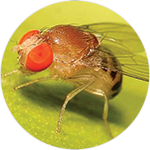
Color: Tan / light with light and dark banding on the abdomen and eyes red in color
Legs: 6
Size: 1/8 of an inch
Antennae: Yes, short in length
Region: Found throughout the U.S.
Fruit flies get their common name from their small size and fondness of over ripening fruits and vegetables. Small fruit flies are nuisance pests. They have been shown to vector food borne pathogens like E coli.
Habits
Fruit flies feed on decaying matter, especially fruits and vegetables.
Habitat
Fruit flies are small pests that are commonly found in homes, restaurants and other facilities where food is processed. They are found on moist, decaying matter that has been stationary for several days.
Threats
Fruit flies are found in unsanitary conditions, so they are a potential health concern, especially when present in health facilities or commercial establishments where food is prepared.
Prevention
Fruit flies are best prevented through vigilant sanitation practices. To exercise proper fruit fly management, remove kitchen trash daily, clean underneath trash receptacle liners and keep counter surfaces clean. Refrigeration of prone fruits and vegetables can also help reduce small fruit fly problems.
House Fly
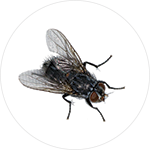
Color: Dark gray with four dark stripes on the area behind the head.
Legs: 6
Size: ¼ of an inch
Antennae: Yes
Region: Found throughout the U.S.
House flies get their name from being the most common fly found around homes. Adult house flies can grow to one-quarter of an inch long and usually live between 15 and 25 days. They can complete their life cycle in as short a time as 7 days.
Habits
They are only able to feed on liquids but have the ability to turn many solid foods into a liquid for them to eat. House flies taste with their feet, which are 10 million times more sensitive to sugar than the human tongue.
Habitat
House flies tend to stay within 1-2 miles of where they were born; however, they have been known to migrate up to 20 miles to find food.
Threats
These insects have been known to carry over 100 different kinds of disease-causing germs, which makes them very bad house guests and pests of public health importance. Among the pathogens associated with house flies are Salmonella, Shigella and Campylobacter.
Prevention
House fly control requires a commitment to vigilant sanitation. Remove trash regularly and use well-sealing garbage receptacles to get rid of house flies around waste bins. Clean up pet waste immediately. Use fine mesh screens on doors and windows to prevent fly entry.
Phorid Fly
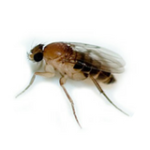 Color: Tan to black with a few dark veins on their wings.
Color: Tan to black with a few dark veins on their wings.
Legs: 6
Shape: Humped back appearance
Size: 1/64″ – 1/4″ of an inch
Antennae: Yes, short in length
Region: Found throughout the U.S.
Habits
Phorid flies are one of the most diverse groups of the structural infesting small flies in their food preferences. They will feed on all types of decaying plant and animal matter. One species has been introduced into the U.S. that is parasitic on red imported fire ants.
Habitat
Phorid flies can be pests of food facilities, hospitals and mausoleums. They will inhabit areas where decaying organic matter is found including garbage receptacles, floor drains, cracks in floors, and grease traps. They have also been known to breed beneath the slab in areas where there has been a sub slab pipe break which resulted in contaminated soil rich in organic material.
Threats
Phorid flies have the potential of contaminating food. Since they may be found in filthy environments like floor drains, the mechanical transport of disease causing organisms is a concern. They have also been documented as infesting open wounds of patients in hospitals.
Prevention
As with many of the structural infesting small flies, removal of the organic material that is supporting fly growth is essential to control. This can include the regular cleaning of floor drains and trash receptacles to remove the fly’s food source. Exclusion can be another important element, especially if flies are feeding and breeding around exterior trash receptacles and dumpsters. Keeping doors closed and well-sealed is part of the program.
Drain/Moth Fly
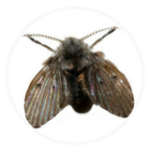 Color: Light gray to black in color with a fuzzy appearance due to the abundance of hours on their wings and body.
Color: Light gray to black in color with a fuzzy appearance due to the abundance of hours on their wings and body.
Legs: 6
Shape: Wings are lemon shaped
Size: 1/16″ – 3/16″ of an inch
Antennae: Yes, short in length
Region: Found throughout the U.S.
Habits
Drain flies are a sluggish fly which often rests on surfaces and is fairly easy to swat and kill. It doesn’t move readily when approached. The immature stages feed on bacteria, algae and fungi living in the slime layer of drains and water treatment plants.
Habitat
Drain flies are more active in the evening hours and will found flying around breeding sites at this time. They can complete their life cycle in as little as 7 days under ideal environmental conditions.
Threats
Although Drain flies breed in sewage and have numerous hairs on their bodies, they are not known to transmit any pathogens to humans or foods. They have been shown to trigger asthmatic reactions in situations where heavy concentrations of dead drain flies and drain fly body parts have accumulated.
Normally, populations are not large inside structures. However, they can be associated with sub slab pipe breaks. In those situations, flies can become quite numerous and threaten food safety. These situations will require repairing the pipe, removal of the contaminated soil and repairing the floor.
Prevention
Most structural based drain fly problems result from poorly maintained floor drains in a building. This not only includes proper cleaning of the drain but maintaining the drain water trap so that the flies cannot readily move through a dry drain. Bioremediation products containing bacteria which helps eliminate organic material inside the drain can be helpful in addition to physical cleaning.
In rare cases, the drain flies may make their way inside from outdoor sources such as water or sewage treatment plants. In that case, exclusion will play a key role in control. They may make their way through normal screening and tighter screen mesh may be required.
Bottle Fly
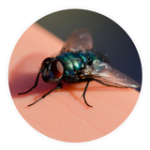 Color: Shiny metallic in color ranging from blue, green, black or brassy.
Color: Shiny metallic in color ranging from blue, green, black or brassy.
Legs: 6
Shape: Small oval
Size: 1/8″ – 5/8″ in length
Antennae: Yes
Region: Found throughout the U.S.
Habits
Bottle flies are attracted to lights and will be found inside insect light traps and along windows. They are excellent fliers and some species may travel over 20 miles.
Habitat
Most species will develop in animal carcasses or meat but if these resources are not available, they will breed in excrement, garbage and decaying vegetation.
Threats
Bottle flies can contaminate food and feed and will readily enter structures. They have been known to infest live tissues in humans also called myiasis. Because they are associated with sewage, excrement and garbage, the potential for picking up pathogens and mechanically transferring them to humans or food is a possibility.
Prevention
Because Bottle flies are great fliers and can travel long distances, the breeding site may not be present at the facility. It is important to practice good exclusion to assist in preventing fly entry into the building.
Fly exclusion includes:
- Keeping doors and windows closed or use of tight fitting screens
- Screening vents which may permit fly entry
- Use of air currents when doors are frequently used
- Use of quick roll up doors or vestibules to help provide another level of defense and separate sensitive areas from less sensitive areas like packaging departments from docks.
In addition, it is important to limit attractions around the structure such as food spills and poorly maintained garbage receptacles. Poorly maintained garbage dumpsters and spilled products can provide breeding sites as well.
